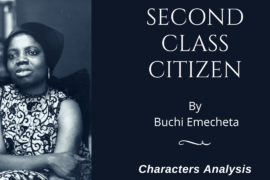In this article, we will be discussing the Analysis of The Leader and the Led by Niyi Osundare, which consists of About the poet, About the book, a comprehensive stanza by stanza analysis, the themes and the figures of speech used in the poem.
About the Poet Niyi Osundare

Niyi Osundare is a Nigerian poet, dramatist, linguist and literary critic. He was born in there-Ekiti, Nigeria, on March 12, 1947. Osundare is well known for his poems in which he depicts African culture as well as issues in Africa. His works are known to be associated with political activism, decolonization, black awareness and eco-literature. He graduated from the University of Ibadan where he obtained his BA in English language and Literature and later proceeded to the University of Leeds for his MA. He obtained his PhD at York University, Canada. Some of his works include Songs from the marketplace, Village Voices, Waiting Laughters, The world is an Egg, Two plays, Not My Business, among others.
The Analysis of The Leader and the Led
The analysis of The Leader and the Led by Niyi Osundare considers the subject matter of the poem, which is the fight for power among politicians in Nigeria and extension, Africa.
Niyi Osundare’s The Leader and the Led is divided into 12 stanzas, consisting of twelve couplets. Constructively, the poem is arranged in a problem-solution order. The first 8 stanzas expose the problem addressed in the poem and the remaining 4 stanzas present the solution to the problem.
The poem is set in a figurative forest with different animals claiming the role of a better ruler. The different animals represent different kinds of leaders seen in the corrupt African system. Each leader possesses qualities associated with greed, selfishness, arrogance, deceit etc. The pack here symbolizes Nigeria(in extension African countries).
READ THE LEADER AND THE LED BY NIYI OSUNDARE POEM HERE
Stanza by Stanza Analysis of The Leader and the Led
The lion known to be fierce, powerful and brave represents the leaders who exercise too much power, yielding to coercion to instil fear in the masses. In the second line, we are reminded of the victims of the lion’s antelope’ and how the lions devour and intimidate the antelopes.
The Antelope here is also a symbol, as it represents the masses, the followers of the leader. The lion is disqualified as ‘the ferocious pounce of his paws’ promote bad leadership.
The next candidate is Hyena. The hyena in line 5 declares that the crown is made for him and as such, he desires the throne. However, in tge next line, we are informed if tge lethal appetite of the hyena, is known only to take over. Hyenas feed in other animal hunts and as such are opportunists. Therefore, the hyena represents leaders who are opportunists, leaders who are selfish and lazy to work. These kinds of leaders are associated with religious bigotry, insecurity, disunity, war, and chaos and as such the Hyena is disqualified.
The third candidate is the Giraffe. The Giraffe is praised for its excellent height and better vision. This quality is however a problem, as the Giraffe’s eyes are too far from the ground; thus too far for him to understand and care for his people.
In comparison, the giraffes represent leaders who only take care of their selfish needs at the expense of the needs of the masses. They are similar to the politicians who loot money meant for the masses, their heads are high up in the skies, ignoring the masses on the ground and as such are rejected by the packs.
Stanza 5 presents the Zebra who is rejected due to the ‘duplicity of its stripes’. The Zebra is known to have several stripes that symbolize deceit and intransparency. Comparable to the Zebra is the unpredictable leaders, they deceive the public by making promises only to fulfil non.
As the poem proceeds, the poet deliberates on the types of leaders, the elephant which is a treat because of its size, the warthog is too ugly and the rhino is a fan of riot and chaos. The pack is indecisive this ‘the pack trashes around like a snake without head’.
The poem offers a solution to the kind of leaders the pack need. The leader is required to have a ‘hybrid of habits; a little of the lamb and a little of the lion, as tough as the tiger and as compassionate as the doe. Leaders should be transparent and mysterious. In conclusion, the poet proclaims that the leader should be conscious of the follower’s right to rule, this display humility, and be considerate of the needs of the masses.
Read Also
Caged Bird Figurative Devices by Maya Angelou
A Comprehensive Analysis Of Black Woman by Leopold Senghor
Analysis Of The Fence By Lenrie Peters
Major barriers in T.S Elliot’s ‘The Love Song of J.Alfred Prufrock’
Themes in The leader and the Led by Niyi Osundare
There are several Themes in the Leader and the Led, however, we will consider the major themes. Dome of the themes in the leader and the led include:
• The theme of Leadership
• The theme of power struggle
• Theme of Arrogance
Themes in The Leader and the Led
• The theme of Leadership
One of the themes in the Leader and the Led is the theme of leadership. This theme is predominant in the poem, as it runs throughout the poem. Osunadre’s main focus in his poem ‘ the leader and the led is the corrupt African society.
Using different animals and their qualities, Osundare illustrates the bad qualities of a leader, which is associated with selfishness, deceit, selfishness etc. The poet concludes that a good leader should possess a hybrid of qualities, being meek and brave, transparent, tough and gentle, above all, be considerate of their followers.
• The theme of power struggle
Another prominent theme in the leader and the leader is the theme of power struggle. Power is a problem in Africa, leaders who have obtained power desire more power and are so clingy that they want to die ruling the country. Osundare in exposing the power struggle in African politics employs a figurative setting portraying different animals laying claim to the throne.
Each ruler wants power for fame and authority, rather than for the good of the masses. In Africa, leaders have shown that power corrupts and over the years the issue of leaders clinging on to power, not wanting to let go is a common problem. Osundare successfully portrays the theme of power struggle in his poem ‘The leader and the led’.
• Theme of Arrogance
This theme will discuss the theme of leadership arrogance in the leader and the led. Arrogance is another vital theme in the poem. The various leaders depicted in this poem show arrogance as they ly claim the throne. They proclaim their right to rule, claiming they are fit because of their physical strength, size or appearance.
They are proud and display no form of humility and are only concerned about their selfish needs. The poem admonishes that a leader should be mindful of the follower’s right to lead, therefore displaying humility and consideration for the masses.
Poetic devices in the Leader and the Led
Poetic devices in the leader and the led depict the figurative devices used in the leader and the led.
The poetic devices in the leader and the led include metaphor, simile, symbolism, paradox and synecdoche.
• Metaphor
The use of metaphor is evident in lines 19 and 20:
“A little bit of a lion
A little bit of a lamb”
In the above, the poet points out the qualities of a lion i.e being brave and the lamb meek.
• Simile
Comparison with the use of like is seen in line 16 :
“Like a snake without ahead”
The above is used to express the state of confusion and lack of direction.
In lines 21 and 22:
“Tough like a tiger, compassionate like a doe
Transparent like a river, mysterious like a lake”
The above implies that the leader should have different qualities, to be flexible to the need of the people.
• Synecdoche
This device is used when a part is used to represent a whole or a whole for a part. In line 4 ‘paws’ is used to represent the lion’s predatory violence against its prey.
In line 8, the word ‘eyes’ is used to represent the Giraffe’s attention toward its people.
In line 10, stripes represent deceit and dishonesty.
• Symbolism
This device is depicted throughout the poem. The entire story and the animals are symbolic as it is a representation of the real world of humans; the political situation in a corrupt African society.
Each animal represents a kind of leader; the lion and the hyena represent oppressive leaders, the Zebra symbolizes deceitful leaders, while the Giraffe represent selfish who distance themselves from the masses.
• Alliteration
In line 4 “pounce …paws” p alliterate
In two 8 ” far from” f alliterates
In line 10 “pack points” p alliterates
In line 14 “rhino…riotous” r alliterates
In line 21 “tough…tiger” t alliterates etc.
• Paradox
This is the placing together of two opposite ideas. This is seen in lines 21 and 22:
“tough like a tiger, compassionate like a doe
transparent like a river, mysterious like a lake”
Although one quality contradicts the other, literary tries to depict that a leader should have a blend of these qualities, a little of this and a little of that.
We’ve given a comprehensive analysis of the poem The Leader and the Led, in which we looked at stanza by stanza analysis, themes in the poem, and the Figures of speech in the poem. We hope this article provides a better understanding and appreciation of the poem The Leader and the Led.
Do well to leave a comment in the comment section if you have any questions.



